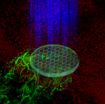(Press-News.org) Advocates of biotech crops and those who favor traditional farming practices such as crop diversity often seem worlds apart, but a new study shows that these two approaches can be compatible. An international team led by Chinese scientists and Bruce Tabashnik at the University of Arizona's College of Agriculture and Life Sciences discovered that the diverse patchwork of crops in northern China slowed adaptation to genetically engineered cotton by a wide-ranging insect pest. The results are published in the advance online edition of Nature Biotechnology.
Genetically engineered cotton, corn and soybean produce proteins from the widespread soil bacterium Bacillus thuringiensis, or Bt, that kill certain insect pests but are harmless to most other creatures including people. These environmentally friendly toxins have been used by organic growers in sprays for decades and by mainstream farmers in engineered Bt crops since 1996. Planted on a cumulative total of more than half a billion hectares worldwide during the past two decades, Bt crops can reduce use of broadly toxic insecticides and increase farmers' profits. However, rapid evolution of resistance to Bt toxins by some pests has reduced the benefits of this approach.
To delay resistance, farmers plant refuges of insect host plants that do not make Bt toxins, which allows survival of insects that are susceptible to the toxins. When refuges near Bt crops produce many susceptible insects, it reduces the chances that two resistant insects will mate and produce resistant offspring. In the United States, Australia and most other countries, farmers were required to plant refuges of non-Bt cotton near the first type of Bt cotton that was commercialized, which produces one Bt toxin named Cry1Ac. Planting such non-Bt cotton refuges is credited with preventing evolution of resistance to Bt cotton by pink bollworm (Pectinophora gossypiella) in Arizona for more than a decade.
Yet in China, the world's number one cotton producer, refuges of non-Bt cotton have not been required. The Chinese approach relies on the previously untested idea that refuges of non-Bt cotton are not needed there because the most damaging pest, the cotton bollworm (Helicoverpa armigera), feeds on many crops other than cotton that do not make Bt toxins, such as corn, soybean and peanuts. The results reported in the new study provide the first strong evidence that these "natural refuges" of non-Bt crops other than cotton delay evolution of pest resistance to Bt cotton.
Tabashnik used computer simulations to project the consequences of different assumptions about the effects of natural refuges in northern China. The simulations mimic the biology of the cotton bollworm and the planting patterns of the 10 million farmers in northern China from 2010 to 2013, where Bt cotton accounts for 98 percent of all cotton, but cotton represents only 10 percent of the area planted with crops eaten by the cotton bollworm.
"Because nearly all of the cotton is Bt cotton, the simulations without natural refuges predicted that resistant insects would increase from one percent of the population in 2010 to more than 98 percent by 2013," said Tabashnik, who heads the UA's Department of Entomology and also is a member of the UA's BIO5 Institute. "Conversely, resistance barely increased under the most optimistic scenario modeled, where each hectare of the 90 percent natural refuge was equivalent to a hectare of non-Bt cotton refuge."
In a third scenario, the researchers used field data on emerging cotton bollworms from different crops to adjust the contribution of each hectare of natural refuge relative to non-Bt cotton. These data were provided by co-author Kongming Wu of the Institute of Plant Protection in Beijing. By this method, the total natural refuge area was equivalent to a 56 percent non-Bt cotton refuge, and 4.9 percent of the insects were predicted to be resistant by 2013.
To distinguish between these possibilities, a team led by co-author Yidong Wu of China's Nanjing Agricultural University tracked resistance from 2010 to 2013 at 17 sites in six provinces of northern China. Insects were collected from the field and more than 70,000 larvae were tested in laboratory feeding experiments to determine if they were resistant. This extensive monitoring showed that the percentage of resistant insects increased from one percent of the population in 2010 to 5.5 percent in 2013.
The field data imply that the natural refuges of non-Bt crops other than cotton delayed resistance with an effect similar to that of a 56 percent non-Bt cotton refuge, just as the model predicted.
"Our results mean we are getting a better understanding of what is going on," Tabashnik said. "We'd like to encourage further documentation work to track these trends. The same kind of analysis could be applied in areas in the U.S. where the natural refuge strategy is used.
"Natural refuges help, but are not a permanent solution," he added. "The paper indicates that if the current trajectory continues, more than half of the cotton bollworm population in northern China will be resistant to Bt cotton in a few years."
To avoid this, the authors recommend switching to cotton that produces two or more Bt toxins and integrating Bt cotton with other control tactics, such as biological control by predators and parasites.
"The most important lesson is that we don't need to choose between biotechnology and traditional agriculture," Tabashnik said. "Instead, we can use the best practices from both approaches to maximize agricultural productivity and sustainability."
INFORMATION:
This work was funded by grants from the Ministry of Agriculture of China (2014ZX08012-004), the National Natural Science Foundation of China (31071983 and 31321004), the 111 program of China (B07030) and the U.S. Department of Agriculture Biotechnology Risk Assessment Grants program (2011-33522-30729).
Predictions of Greenland ice loss and its impact on rising sea levels may have been greatly underestimated, according to scientists at the University of Leeds.
The finding follows a new study, which is published today in Nature Climate Change, in which the future distribution of lakes that form on the ice sheet surface from melted snow and ice - called supraglacial lakes - have been simulated for the first time.
Previously, the impact of supraglacial lakes on Greenland ice loss had been assumed to be small, but the new research has shown that they will migrate farther ...
Sparks literally fly when a sperm and an egg hit it off. The fertilized mammalian egg releases from its surface billions of zinc atoms in "zinc sparks," one wave after another, a Northwestern University-led interdisciplinary research team has found.
Using cutting-edge technology they developed, the researchers are the first to capture images of these molecular fireworks and pinpoint the origin of the zinc sparks: tiny zinc-rich packages just below the egg's surface.
Zinc fluctuations play a central role in regulating the biochemical processes that ensure a healthy ...
When someone you know is wearing an unfamiliar hat, you might not recognize them. Georgia Institute of Technology researchers are using just such a disguise to sneak biomaterials containing peptide signaling molecules into living animals.
When the disguised peptides are needed to launch biological processes, the researchers shine ultraviolet light onto the molecules through the skin, causing the "hat" structures to come off. That allows cells and other molecules to recognize and interact with the peptides on the surface of the material.
This light-activated triggering ...
BOSTON - December 15, 2014 - In a study published today by Nature, researchers at Joslin Diabetes Center used a microscopic worm (C. elegans) to identify a new path that could lead to drugs to slow aging and the chronic diseases that often accompany it--and might even lead to better cosmetics.
The Joslin team looked at how treatments known to boost longevity in the one-millimeter long C. elegans (including calorie restriction and treatment with the drug rapamycin) affected the expression of genes that produce collagen and other proteins that make up the extra-cellular ...
New research into an Icelandic eruption has shed light on how the Earth's crust forms, according to a paper published today in Nature.
When the Bárðarbunga volcano, which is buried beneath Iceland's Vatnajökull ice cap, reawakened in August 2014, scientists had a rare opportunity to monitor how the magma flowed through cracks in the rock away from the volcano. The molten rock forms vertical sheet-like features known as dykes, which force the surrounding rock apart.
Study co-author Professor Andy Hooper from the Centre for Observation and Modelling ...
The carbon in the atmosphere, ocean, surface life, and other shallow, near surface reservoirs accounts for only about 10% of Earth's carbon. Where is the other 90%? What is it doing? Does it matter?
The Deep Carbon Observatory (DCO), an ambitious 10-year (2009-2019) program of exploration and experimentation, pursues the mysterious 90% while building a new scientific field with a network of scientists from more than 40 countries. Recent results from DCO researchers are filling in the global carbon puzzle with findings that extend our understanding of the origins and limits ...
Researchers at Yale and Boston University and their Russian collaborators have found that occasional heroin use by HIV-positive patients may be particularly harmful to the immune system and worsens HIV disease, compared to persistent or no heroin use.
The findings are published in the journal AIDS and Behavior.
"We expected that HIV-positive patients who abused heroin on an ongoing basis would have the greatest decreases in their CD4 count, but this preliminary study showed that those who abused heroin intermittently had lower CD4 cell counts, indicating a weakened ...
The introduction of neutral umpires in Test cricket led to a drop in the number of LBW decisions going in favour of home teams, a study has revealed.
The findings from research by economists, published by the Journal of the Royal Statistical Society, come amidst renewed debate on whether neutral umpiring is still required in Test matches following the introduction of the Decision Review System (DRS).
Economists Dr Abhinav Sacheti and Professor David Paton from Nottingham University Business School and Dr Ian Gregory-Smith from the University of Sheffield analysed Leg ...
This news release is available in Japanese. New research published in the journal genesis, by Kenneth Baughman, Dr. Eiichi Shoguchi, Professor Noriyuki Satoh of the Marine Genomics Unit at the Okinawa Institute of Science and Technology Graduate University, and collaborators from Australia, reports an intact Hox cluster in the Crown of Thorns starfish, Acanthaster planci. This surprising result contrasts with the relatively disorganized Hox cluster found in sea urchins, which are also echinoderms, classification of animals including starfish, sea lilies, and sea cucumbers. ...
SALT LAKE CITY, Dec. 15, 2014 -- Because of undetected toxicity problems, about a third of prescription drugs approved in the U.S. are withdrawn from the market or require added warning labels limiting their use. An exceptionally sensitive toxicity test invented at the University of Utah could make it possible to uncover more of these dangerous side effects early in pharmaceutical development so that fewer patients are given unsafe drugs.
To prove the point, the U researchers ran their test on Paxil, an antidepressant that thousands of pregnant women used in the years ...







